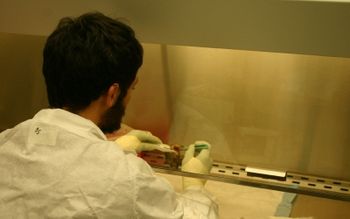
Youth, prison inmates and individuals with multiple tattoos that cover large parts of their bodies are at higher risk of contracting hepatitis C and other bloodborne diseases, according to a University of British Columbia study.

Youth, prison inmates and individuals with multiple tattoos that cover large parts of their bodies are at higher risk of contracting hepatitis C and other bloodborne diseases, according to a University of British Columbia study.

Observing what Internet users type into Web search engines could be a unique way to conduct infectious disease surveillance, according to researchers at the Swedish Institute for Infectious Disease Control in Solna, Sweden.

The National Viral Hepatitis Roundtable (NVHR) said today that legislation introduced by Sen. John Kerry, "The Viral Hepatitis and Liver Cancer Control and Prevention Act," would transform the country's approach to identifying and treating chronic viral hepatitis B and C.

Prolonged catheterization is the primary risk factor for catheter-associated urinary tract infection (CAUTI). Reminder systems are interventions used to prompt the removal of unnecessary urinary catheters. Prolonged catheterization is the primary risk factor for catheter-associated urinary tract infection (CAUTI). Reminder systems are interventions used to prompt the removal of unnecessary urinary catheters.

Decision Resources reports that in first- and second-line treatment of Clostridium difficile infection (CDI), nearly 70 percent of surveyed infectious disease specialists and internists will use Optimer's fidaxomicin and nearly half will use Medarex/Merck's CDA1 and CDB1, one year after the launch of these agents.

Researcher finds that cross-species transmission may have less to do with virus mutation and contact rates and more to do with host similarity.

Like most infectious diseases, rabies can attack several species. However, which species are going to be infected and why turns out to be a difficult problem that represents a major gap in our knowledge of how diseases emerge.

As the medical community searches for better vaccines and ways to deliver them, a University of Rochester scientist believes he has discovered a new approach to boosting the bodys response to vaccinations. Richard P. Phipps, PhD, found that the same molecules used in drugs that treat diabetes also stimulate B cells in the immune system, pushing them to make antibodies for protection against invading microorganisms.

Detailed pictures published today reveal how a new type of experimental antibiotic can kill bacteria that are already resistant to existing treatments. The findings could ultimately help scientists to develop new antibiotics to tackle the bacteria responsible for many hospital and community-acquired infections.

The Association for Professionals in Infection Control and Epidemiology (APIC) says it is encouraged by the final rule announced by the Centers for Medicare and Medicaid Services (CMS).


ICU Medical, Inc., a manufacturer of disposable medical connection systems for use in vascular therapy applications, today confirmed that it has received FDA 510-k clearance for the Neutron Neutral-Pressure Needleless Connector.

Now that the infection prevention and control community has had some time to learn about the Food and Drug Administration (FDA)s concerns regarding positive-displacement needleless connectors and the possible link to bloodstream infections (BSIs) and patient mortality, the question seems to be, now what?

Recommendations focus on innovation, regulatory predictability, and patient safety as related to medical devices.



A recent report from Textiles Intelligence in the United Kingdom indicates that smart textiles and nanotechnology will enhance the benefits of personal protective equipment (PPE) used to protect workers from occupational exposures, hazardous materials, and pathogens that trigger infectious diseases.

Introduction of the PCV-7 vaccine to prevent invasive pneumococcal disease (IPD) has led to a shift in the types of bacteria causing hemolytic uremic syndrome, an important cause of acute kidney failure in children, reports a study in the August issue of the Pediatric Infectious Disease Journal.

New research suggests that blocking a membrane protein called "Programmed Death 1" improves survival in a clinically relevant model of severe infection.

Research on plague and prairie dogs published in the Proceedings of the National Academy of Sciences could have significant implications for understanding how infectious diseases spread in animals and humans.

The Florida Times-Union is reporting today on the case of Jean Law, a nurse on staff at Baptist Medical Center-South in Jacksonville, Fla. who contracted a bacterial infection and had to have both legs and eight fingers amputated because staff at the facility allegedly failed to diagnose her septic condition quickly enough.

The Oncology Nursing Society has released the findings of a recent survey of oncology nurses that show they are increasingly concerned about invasive fungal infections in their patients.

During an influenza pandemic, a substantial proportion of transmission is thought to occur in households.

Data on the performance of Mycobacterium-tuberculosis-specific interferon-(IFN)-gamma release assays (IGRAs) in the serial testing of healthcare workers is limited.

Researchers at Case Western Reserve University developed techniques to quickly identify evolution of drug resistance in strains of malaria.

The vast majority of pediatricians and family physicians nationally are offering the human papillomavirus (also called HPV) vaccine, though fewer physicians are strongly encouraging it for 11- to 12-year-old girls as recommended by national guidelines.

In a letter to infection preventionists, the Food and Drug Administration (FDA), is informing them about positive displacement needleless connectors and the possible link to several patient deaths associated with bloodstream infections (BSIs).

In todays environment, the delivery of healthcare is constantly evolving, requiring practitioners to be nimble and quickly adapt to new guidelines, protocols and technology.

Researchers describe a novel device that utilizes immunosensor and bio-optical technology to detect M. tuberculosis antigen (Ag85B) in cough and demonstrate its use under field conditions during a pilot study in an area of high TB incidence.